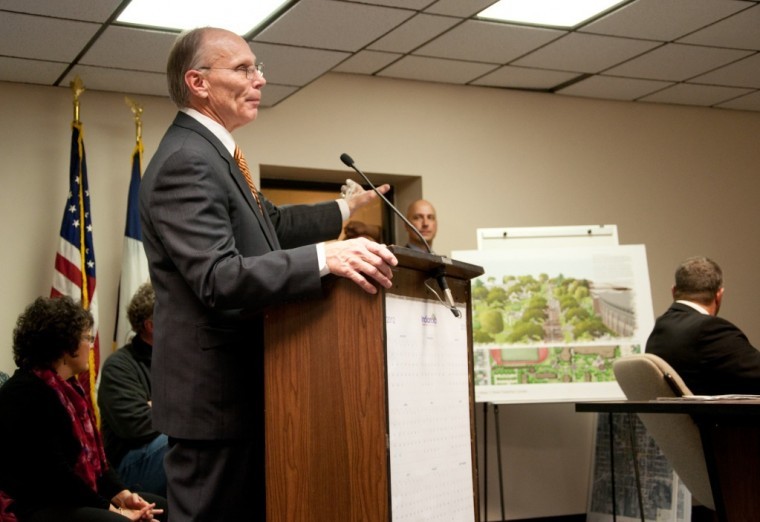Simpson moves forward in C Street proposal
February 28, 2012
Simpson College President John Byrd delivered a proposal to close C Street at last Tuesday night’s city council meeting, escalating tensions regarding the project.
The college has been looking to transform the street into a pedestrian walkway, bringing concerns to Indianola residents.
Byrd first discussed benefits the project would provide. Improved student safety, unifying and beautifying the campus and making the college more appealing to prospective students to better compete with other colleges were the key benefits mentioned.
Improved students safety is a top benefit for many.
“That’s one of the things that my parents commented on when we visited here was the fact that C Street ran directly through campus and at times it is a safety hazard,” said Kyle Hauswirth, a freshman and member of Student Government Association.
Since the project was first presented, many residents have voiced their concern over effects the project will have on the community, creating tension between the college and Indianola residents.
As a 32-year resident of Indianola, Ken Beane has long ties with the town. He also has close ties with the college, as he is a part time faculty member of the college. Beane was also employed in the Indianola School District for 27 years. He insists the community and college must come together on a decision.
“I’ve heard a lot of I (statements),” said Beane prior to the meeting. “I want this, I did this. I think it’s time to think about we instead of I. We need to embrace the whole community and make sure that everybody is satisfied.”
Byrd also expressed the need to agree.
“We have been listening very carefully to feedback from the community,” Byrd said.
He addressed four main concerns vocalized by Indianola residents regarding the project, particularly concerns raised at a town forum held Nov. 10. Following the forum, various issues were studied and last Tuesday’s meeting offered a chance to present findings.
The first issue addressed was the effect the closure would have on traffic flow near Irving Elementary School. Citizens were concerned that the closing would increase already busy traffic near the school, risking the safety of young children and congesting the area even more.
Irving Superintendent Mike Teigland discussed recent expansion plans that would lessen the congestion of the area and improve the safety of students.
A traffic study was also conducted to address the question of increased traffic following the street closing.
“It was found that if C Street were closed, it would typically funnel only about one to two cars more per minute that would possibly go to the west if all of the traffic went to the west,” Teigland said.
Teigland also said that although the school remains neutral in its position on the closing, it would be fine with the closure happening.
Byrd then addressed the concern for a lack of emergency vehicle access to the college if the street were closed. A representative from Confluence, a professional consulting firm of landscape architects and planners, discussed various plans the firm implemented at other colleges that could be incorporated at Simpson to accommodate the problem.
Parking was another major concern frequently voiced, as many students park alongside the street. According to Byrd, parking isn’t the problem- there are plenty of spaces. It’s the walking that is problematic, as students only like parking as close as they can to their locations.
Byrd showed results of a study the college performed to learn more about the issue. All open parking spaces were recorded every hour throughout the weekdays. It was found that many spots were still available across the campus even during the busiest hours of the day.
Areas and parking lots that were congested or raised concern were evaluated, and plans to improve the areas were put in place.
A number of students that live in Barker Hall, for example, have already been given parking permits for the nearby Washington apartment complex parking lot, keeping Gerard Street, where these students typically parked, less congested.
The last issue brought on by the project was the issue of traffic flow, an important issue for many residents.
“C Street is a main travel road,” Indianola resident Bonnie McKinney said. “It’s the only one that goes from Highway 92 clear north in order to get to the north side of town.”
Byrd stated that this issue should be studied, a decision the city must make, not the college. He assured that plenty of time could be allowed to figure out the issues before any action is taken.
Next, Byrd laid out what plans have been made for the removal of the street, plans very similar to those developed in December. The plans included additional parking, pedestrian walkways, and cul-de-sacs on either end of the street that would allow prospective students to be able to drive in and experience the campus.
An events plaza would also be incorporated on the north end off the cul-de-sac. This would mean cutting into a section of the city-owned Buxton Park, another concern for residents.
“We view this space from end to end as a wonderful resort for the city of Indianola,” Byrd said. “We would love to make it available for arts fairs and outdoors events.”
He added that features in the new student center aren’t offered other places in city and that its access to facilities would make it an ideal location for community events.
“We look for ways to engage ourselves with community members and truly be a part of the Indianola community,” said Joe Sorenson, senior and student body president.
Byrd then called for immediate coordination between the college and the city in executing a plan to improve C Street following the plan discussed with the council in December. This would include the repaving and beautification of the street to be done ideally by next October in coordination with the completion of the student center.
Byrd also called for a negotiated price for the land occupied by the street so that Simpson could purchase the street and begin the project, making the college financially responsible for any improvements and work done on the street.
The council decided to schedule a study session
to review the proposal before making any decisions.
Council member Pam Pepper addressed the need to first allow citizens to speak their thoughts on the issue.
“The point of tonight was not a public hearing, it was for us to receive a report from Simpson,” Indianola Mayor Ken Bresnan said. “Not saying that we might not get to that point, but I’d like more of a direction from the council on how they’d like to proceed.”
Discussion over allowing the public to speak continued, mounting tensions.
“The point of tonight was the presentation, it is not the point to question the college at this meeting, it’s not a public meeting,” Bresnan said.
However anyone who had statements, not questions, was invited to come forward. Residents who came forward questioning intentions were quickly stopped and dismissed.
Those who came forward had strong opinions and thoughts against the proposal, proving the issue to be a sensitive and touchy topic.
McKinney, a Simpson graduate, has lived on West Clinton for 40 years.
“I love Simpson College,” McKinney said. “That’s where I grew up. I’ve been a supporter of the college for a long time but after you live in a community for awhile you realize that the community doesn’t revolve around Simpson College.”
Bresnan ended the discussion with a decision to schedule an open meeting that would allow the public to meet with Byrd, ask questions and raise concerns about the project.






